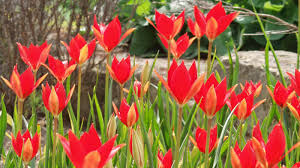We have rain. It started last Wednesday, a steady gentle drizzle that went on for hours, slowly soaking into the soil. Lawns which had been getting steadily more and more straw coloured are eagerly soaking it up. Now, there is a distinct green tinge to all of them, and the blades of grass are standing up straight. They look like soldiers, who on the edge of defeat were downcast and demoralised, and now are resolute and determined knowing that the tide has changed and that help is on its way. In short, the grass is looking a lot happier and healthier.
Since Wednesday it has rained a lot. This morning there have been heavy showers, with short spells of sunshine. Typical spring weather you might say, except that this is now June. Flaming June! When light dominates the days, when night is almost banished, when the sun rises in the north-east, climbs high into the sky and sets in the north west. There were some evenings in late May when even at 11pm the northern sky was a deep blue and far over in the west you could see the last lingering embers of the sunset, almost an hour and a half after the sun had gone. On such nights it is very difficult to think that in just six months time the picture will be extremely different. But if you live in the northern hemisphere, and on the same latitude as southern Alaska, that’s what you’ll see.
One of the things we often overlook in the UK is just how far north we are. We are further north than Japan, China, all of the USA with the exception of Alaska. We are further north than Toronto, Montreal, Seattle, New York and Boston. All cities in the US and Canada that we equate with cold snowy winters. The other thing we take for granted is the Gulf Stream that brings warm water across the Atlantic and which moderates our temperature. Climate change may well alter all this. There is of course another stream, the Jet Stream, which plays a major role in Britain’s weather; and brought us all the rain and windy weather over winter; and climate change is definitely playing havoc with the Jet Stream’s expected pattern of behaviour.
Right now though the trees, plants and grass are sparkling with rain-drops, although as I type another batch of grey clouds has come marching up ready to drop more water; and unlike January when I was heartily sick of the sight of it, this time I’m grateful. If it’s still raining like this in August then I may well think differently, but right now I’m looking at all the plants in my garden that are growing and thriving. They’ve had sun, almost too much and now those that have hung on, are getting water; and soil is getting softer and changing colour from a dusty clay to moist fertile blackness. Now, if the rain can just let up a little I can get outside and plant cosmos and lobelia, with no need to water them in!
 Today is the 30th May. Right now it is midday. It has been a very dry spring in the UK. I think it stopped raining in February and we’ve not really had much since. Both April and May have been very dry. The worry is that June, July and August, even September, will also be dry and then we’ll have a drought. This will be in complete contrast to the situation we had in winter where we had too much water. In December and January there were pictures on the television of rivers bursting their banks. In Yorkshire a temporary lake formed that was larger than Lake Windermere – the largest lake in England. I suspect it has gone now.
Today is the 30th May. Right now it is midday. It has been a very dry spring in the UK. I think it stopped raining in February and we’ve not really had much since. Both April and May have been very dry. The worry is that June, July and August, even September, will also be dry and then we’ll have a drought. This will be in complete contrast to the situation we had in winter where we had too much water. In December and January there were pictures on the television of rivers bursting their banks. In Yorkshire a temporary lake formed that was larger than Lake Windermere – the largest lake in England. I suspect it has gone now.

